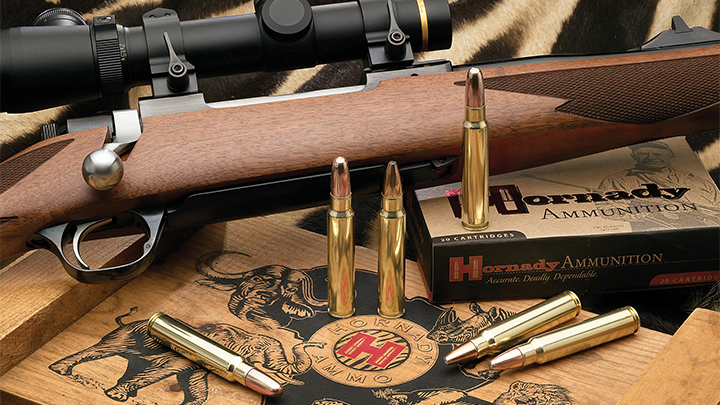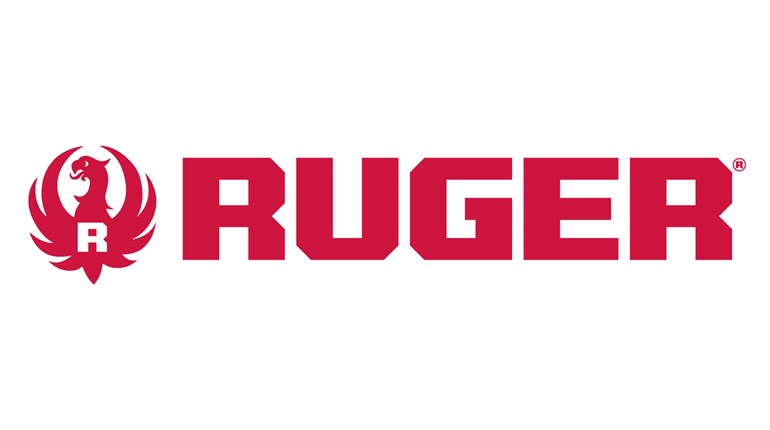
If I was forced to choose—and thank Heaven that I am not—just one bore diameter to cover the entire range of the world’s big game, it would have to be the .375-inch bore diameter. Though it does few things perfectly, it truly does everything, and is possibly the most flexible bore diameter available. The bullet weights for the most common cartridges will range from 200 grains all the way up to 350 grains (380 grains in a few instances with boutique bullets) and at what we’ve come to accept as standard velocities, will both shoot flat with spitzer bullets and hit hard with the heavyweights.

Though it wasn’t the first—and it certainly isn’t the last—the .375 Holland & Holland Belted Magnum set the standard for not only the proper velocities, but the desired terminal ballistics for the .375-inch diameter. Released in 1912, the .375 H&H took a while to become the revered, all-around design we know; the Great War put a damper on international hunting adventures. But, it eventually rose to the top, and not just among African hunters. Those hunting the wilds of India, Australia, Canada and the United States all were well-served by the .375 H&H. After the Second World War, when supplies of British ammunition for the sporting rifles became scarce at best, the American ammunition kept the industry supplied, though the choice was pretty much between the .375 H&H Magnum and the .458 Winchester Magnum.

There have been many cartridges designed to compete or replace the .375 H&H, including the .375 Weatherby Magnum and its larger brother the .378 Weatherby Magnum, the .375 Dakota, the .376 Steyr and the .375 Remington Ultra Magnum; while all of them have a following, none have approached the flowing of the H&H design. The one cartridge which has, in my opinion, come the closest is the .375 Ruger. It is simple, effective, affordable (in both rifle and ammunition) and shootable. It truly mirrors the velocities of the H&H case in a cartridge housed in a standard long action (versus the magnum action needed for the H&H), in a beltless, rimless design.
The engineers at Hornady and Ruger teamed up in 2007 to produce a cartridge case with no parent; the .375 Ruger is a unique design. It uses a .532-inch rim diameter (the same as the .375 H&H and its subsequent offspring) which I assume would make it financially beneficial to machine the rifle’s bolt, and a rimless design with very little body taper. The case measures .532 inches at the base and .515 inches at the shoulder—giving a larger body diameter than the H&H design—and is equipped with a 30-degree shoulder for positive headspacing. With a case length of 2.580 inches and an overall length of 3.340 inches, the .375 Ruger will fit perfectly in a long-action receiver which will house a .300 Winchester Magnum or 7mm Remington Magnum. It was designed to use the same 1:12-inch twist rate of the .375 H&H Magnum barrels, the neck length of .305 inches, while shorter than one-caliber in length, has not posed an issue in my experience.

Looking at the case volume, in spite of being .270 inches shorter than the .375 H&H Magnum, the .375 Ruger actually has a greater volume; about 4 percent, depending on case brand. The .375 Ruger is actually capable of generating higher velocities than the H&H, by roughly 100 fps in a 24-inch barrel. And much like the H&H case, the recoil of the .375 Ruger is easy enough for most shooters to handle; the cartridge generates right around 4,800 ft.-lbs. of energy at the muzzle, making it adequate to handle all of the world’s game species.
Hornady is the predominant source of ammunition for the .375 Ruger, and they offer a quartet of loads, making the cartridge suitable for nearly any hunting situation. The Outfitter load features a 250-grain GMX (a lead-free choice), at a muzzle velocity of 2800 fps and will give a trajectory much like a .308 Winchester with a 180-grain bullet; with a 200-yard zero, it’ll strike eight inches low at 300 yards and 23 inches low at 400 yards.

In the Dangerous Game Series, Hornady loads their 270-grain InterLock spitzer at a muzzle velocity of 2840 fps, yielding a trajectory identical to the lighter 250-grain bullet and making it a perfect choice for bear, elk, moose, African plains game and the big cats as well. And lastly, the duo of Hornady’s 300-grain DGX Bonded and DGS Solid, at a muzzle velocity of 2660 fps for 4,713 ft.-lbs. of muzzle energy is where the .375 Ruger shines as dangerous game cartridge. With deep penetration and high weight retention, the DGX Bonded has earned a great reputation—bonding the core to the jacket solved some jacket/core separation issues—and the DGS remains a fantastic choice for backup on buffalo, or for hunting elephant.
Handloading for the .375 Ruger is a straightforward affair; look to a large rifle magnum primer and powders like Reloder 15, 16 and 17, H380, VARGET and IMR4064, IMR4166, IMR4350 and IMR4451, depending on the bullet your loading. While the Hornady bullets are excellent, handloading for the .375 Ruger will open the floodgates of possibilities.

The .375 Ruger has gone on to raise quite the family, including the .416 Ruger, the .300 and .338 Ruger Compact Magnums, and the 6.5 PRC and .300 PRC. Will it ever unseat the .375 H&H Magnum as the king of the .375s? I doubt it; there are just too many great rifles chambered for the H&H, too many ammunition choices, as well as too many devotees of the old, belted case. But for someone who wants a no-nonsense cartridge in an affordable rifle, the .375 Ruger in the Hawkeye rifle makes a great choice.
Looking for previous installments of our "Behind the Bullet" series? We've got you covered.
• .223 Remington
• 6.5x55 Swedish
• .416 Remington Magnum
• .300 Winchester Short Magnum
• 28 Nosler
• 6.5 PRC
• .22 WMR
• .458 Winchester Magnum
• .22 Hornet
• .280 Ackley Improved
• .240 Weatherby Magnum
• .458 Lott
• .264 Winchester Magnum
• .348 Winchester
• .33 Nosler
• .260 Remington
• .30-30 Winchester
• .416 Rigby
• .358 Norma Magnum
• .22 LR
• 7mm-08 Remington
• 8mm Remington Magnum
• .338 Federal
• .224 Valkyrie
• .338-06 A-Square
• 9.3x62mm Mauser
• .257 Weatherby Magnum
• .45-70 Government
• .300 H&H Magnum
• .25-06 Remington
• .30-06 Springfield
• 6.5 Creedmoor
• .300 Remington Ultra Magnum
• 7mm Remington Magnum
• .470 Nitro Express
• .280 Remington
• .300 Winchester Magnum
• .270 Winchester
• .222 Remington
• .45 ACP
• .404 Jeffery
• .44 Remington Magnum
• .41 Remington Magnum
• .243 Winchester
• .338 Winchester Magnum
• .357 S&W Magnum
• 6.5-284 Norma
• 8x57 Mauser
• .38 Smith & Wesson Special
• 7x57mm Mauser
• 9mm Luger
• .35 Whelen
• .454 Casull
• .375 H&H Magnum
• .45 Colt
• .22-250 Remington
• 10mm Auto
• .308 Winchester



































